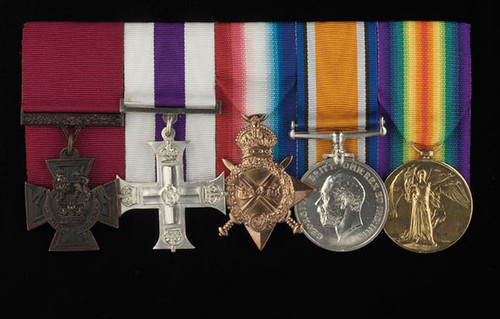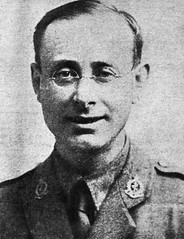
PREV ARTICLE
NEXT ARTICLE
FULL ISSUE
PREV FULL ISSUE
LORD ASHCROFT ON CAPTAIN ACKROYD'S MEDALSLord Ashcroft’s collection of Victoria Cross medals and other medals for gallantry is on public display at the Imperial War Museum, London. In this article published August 11, 2017
in the Expess, he discusses the medals of hero Captain Harold Ackroyd. -Editor
 To his commanding officer, Lieutenant-Colonel BE Clay, he was “the most gallant man I have ever met”. To the young soldiers from his battalion, he was an inspirational figure who repeatedly risked his life to tend to their wounds just yards from the front line. Yet aged 40, bespectacled and with thinning grey hair, temporary Captain Harold Ackroyd was an unlikely hero as he earnestly undertook his medical duties a century ago on the muddy Flanders fields close to the Belgian town of Ypres. he served in France and Belgium for two long years at the height of the 1914-18 war, the repeated risks that he took made it clear that his commitment to his king, country and comrades was constantly endangering his life. In fact Captain Ackroyd was killed in action 100 years ago today, 10 days after showing such outstanding bravery in the Battle of Passchendaele that he was awarded a posthumous Victoria Cross (VC), Britain and the Commonwealth’s most prestigious gallantry medal. I am the privileged custodian of Captain Ackroyd’s gallantry and service medals, having purchased them privately 14 years ago. This is my personal tribute to a man who fully deserves to be recognised as one of the “bravest of the brave”.
The attack on Glencorse Wood on July 31 and August 1, though courageous, was confused and poorly organised, as the 6th Berkshires moved closer towards a well-prepared enemy and into an area that was already thought to have been captured. Captain Ackroyd roamed up and down the line to treat casualties and was eventually awarded the VC for his gallantry over the two days. The citation for his decoration, announced on September 6, 1917, stated: “During recent operations Captain Ackroyd displayed the greatest gallantry and devotion to duty. Utterly regardless of danger he worked continuously for many hours up and down and in front of the line tending the wounded and saving the lives of officers and men. “In so doing he had to move across the open under heavy machine-gun, rifle and shell fire. He carried a wounded officer to a place of safety under very heavy fire. On another occasion he went some way in front of our advanced line and brought in a wounded man under continuous sniping and machine-gun fire. “His heroism was the means of saving many lives and provided a magnificent example of courage, cheerfulness and determination to the fighting men in whose midst he was carrying out his splendid work.” However by the time that his VC was announced Captain Ackroyd was dead. He had been killed by an enemy sniper at Jargon Trench while close to the front line, having set out to find and treat the wounded on August 11, 1917. He was one of seven men shot dead in a shell-hole by snipers and he was buried at Birr Cross Roads Cemetery, Zillebeke, Belgium. To read the complete article, see: Wayne Homren, Editor The Numismatic Bibliomania Society is a non-profit organization promoting numismatic literature. See our web site at coinbooks.org. To submit items for publication in The E-Sylum, write to the Editor at this address: whomren@gmail.com To subscribe go to: https://my.binhost.com/lists/listinfo/esylum All Rights Reserved. NBS Home Page Contact the NBS webmaster 
|
